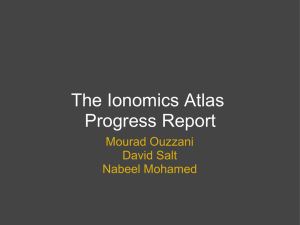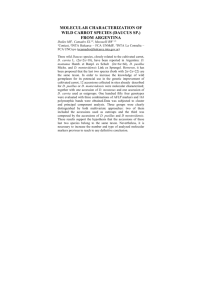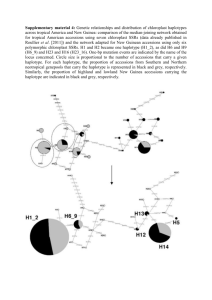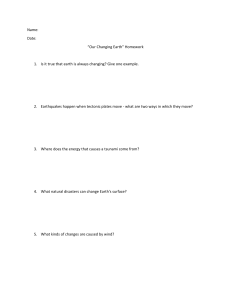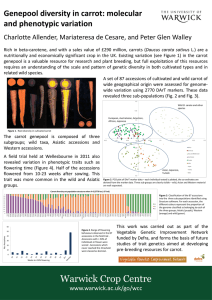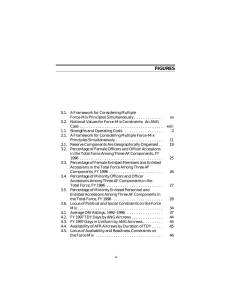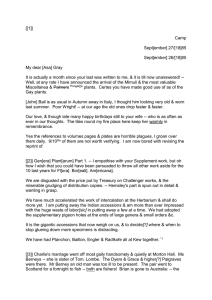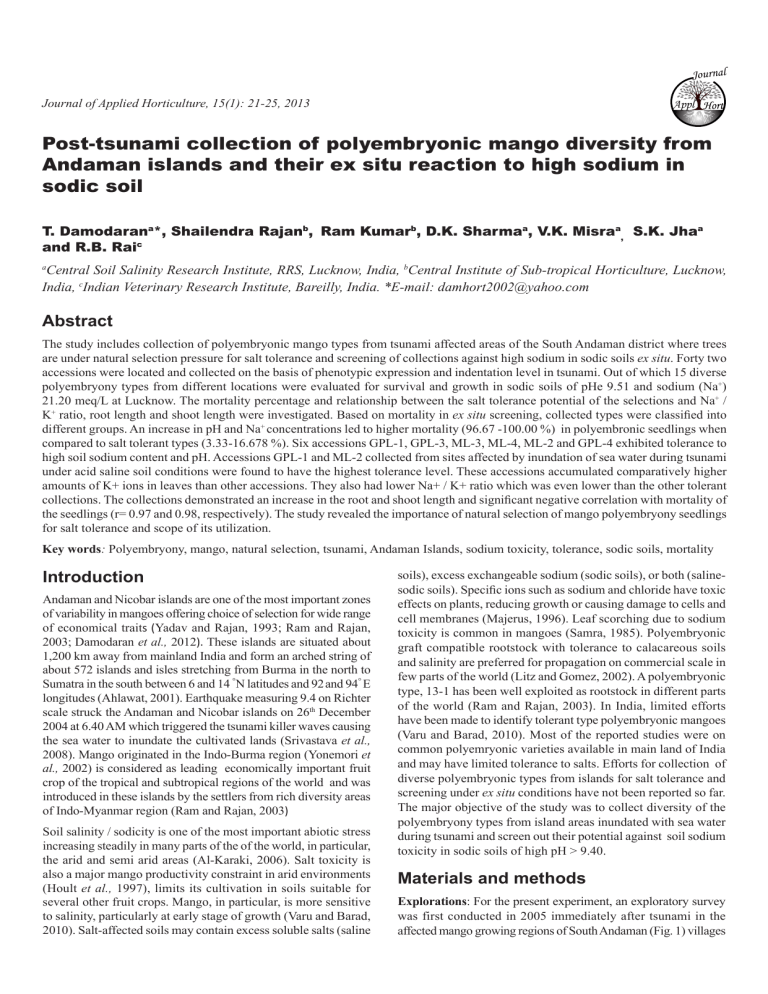
Journal Appl Journal of Applied Horticulture, 15(1): 21-25, 2013 Post-tsunami collection of polyembryonic mango diversity from Andaman islands and their ex situ reaction to high sodium in sodic soil T. Damodarana*, Shailendra Rajanb, Ram Kumarb, D.K. Sharmaa, V.K. Misraa, S.K. Jhaa and R.B. Raic a Central Soil Salinity Research Institute, RRS, Lucknow, India, bCentral Institute of Sub-tropical Horticulture, Lucknow, India, cIndian Veterinary Research Institute, Bareilly, India. *E-mail: damhort2002@yahoo.com Abstract The study includes collection of polyembryonic mango types from tsunami affected areas of the South Andaman district where trees are under natural selection pressure for salt tolerance and screening of collections against high sodium in sodic soils ex situ. Forty two accessions were located and collected on the basis of phenotypic expression and indentation level in tsunami. Out of which 15 diverse polyembryony types from different locations were evaluated for survival and growth in sodic soils of pHe 9.51 and sodium (Na+) 21.20 meq/L at Lucknow. The mortality percentage and relationship between the salt tolerance potential of the selections and Na+ / K+ ratio, root length and shoot length were investigated. Based on mortality in ex situ screening, collected types were classified into different groups. An increase in pH and Na+ concentrations led to higher mortality (96.67 -100.00 %) in polyembronic seedlings when compared to salt tolerant types (3.33-16.678 %). Six accessions GPL-1, GPL-3, ML-3, ML-4, ML-2 and GPL-4 exhibited tolerance to high soil sodium content and pH. Accessions GPL-1 and ML-2 collected from sites affected by inundation of sea water during tsunami under acid saline soil conditions were found to have the highest tolerance level. These accessions accumulated comparatively higher amounts of K+ ions in leaves than other accessions. They also had lower Na+ / K+ ratio which was even lower than the other tolerant collections. The collections demonstrated an increase in the root and shoot length and significant negative correlation with mortality of the seedlings (r= 0.97 and 0.98, respectively). The study revealed the importance of natural selection of mango polyembryony seedlings for salt tolerance and scope of its utilization. Key words: Polyembryony, mango, natural selection, tsunami, Andaman Islands, sodium toxicity, tolerance, sodic soils, mortality Introduction Andaman and Nicobar islands are one of the most important zones of variability in mangoes offering choice of selection for wide range of economical traits (Yadav and Rajan, 1993; Ram and Rajan, 2003; Damodaran et al., 2012). These islands are situated about 1,200 km away from mainland India and form an arched string of about 572 islands and isles stretching from Burma in the north to Sumatra in the south between 6 and 14 ◦N latitudes and 92 and 94◦ E longitudes (Ahlawat, 2001). Earthquake measuring 9.4 on Richter scale struck the Andaman and Nicobar islands on 26th December 2004 at 6.40 AM which triggered the tsunami killer waves causing the sea water to inundate the cultivated lands (Srivastava et al., 2008). Mango originated in the Indo-Burma region (Yonemori et al., 2002) is considered as leading economically important fruit crop of the tropical and subtropical regions of the world and was introduced in these islands by the settlers from rich diversity areas of Indo-Myanmar region (Ram and Rajan, 2003) Soil salinity / sodicity is one of the most important abiotic stress increasing steadily in many parts of the of the world, in particular, the arid and semi arid areas (Al-Karaki, 2006). Salt toxicity is also a major mango productivity constraint in arid environments (Hoult et al., 1997), limits its cultivation in soils suitable for several other fruit crops. Mango, in particular, is more sensitive to salinity, particularly at early stage of growth (Varu and Barad, 2010). Salt-affected soils may contain excess soluble salts (saline soils), excess exchangeable sodium (sodic soils), or both (salinesodic soils). Specific ions such as sodium and chloride have toxic effects on plants, reducing growth or causing damage to cells and cell membranes (Majerus, 1996). Leaf scorching due to sodium toxicity is common in mangoes (Samra, 1985). Polyembryonic graft compatible rootstock with tolerance to calacareous soils and salinity are preferred for propagation on commercial scale in few parts of the world (Litz and Gomez, 2002). A polyembryonic type, 13-1 has been well exploited as rootstock in different parts of the world (Ram and Rajan, 2003). In India, limited efforts have been made to identify tolerant type polyembryonic mangoes (Varu and Barad, 2010). Most of the reported studies were on common polyemryonic varieties available in main land of India and may have limited tolerance to salts. Efforts for collection of diverse polyembryonic types from islands for salt tolerance and screening under ex situ conditions have not been reported so far. The major objective of the study was to collect diversity of the polyembryony types from island areas inundated with sea water during tsunami and screen out their potential against soil sodium toxicity in sodic soils of high pH > 9.40. Materials and methods Explorations: For the present experiment, an exploratory survey was first conducted in 2005 immediately after tsunami in the affected mango growing regions of South Andaman (Fig. 1) villages 22 Post-tsunami collection of polyembryonic mangoes from Andaman Islands and their ex situ reaction through a transect survey starting from the head quarters Port Blair. Subsequent survey was made during 2012 based on the results of the earlier collections and diverse conditions in island (Table 1). for recording the root and shoot length (cm). A set of untreated control was maintained to assess the effect of sodicity on the polyembryonic types. Table 1. Collection site characterstics Site Feature Statistical analysis: The experiment was laid out in completely randomized design with three replication having ten numbers of plants in each replication. The data was analyzed using analysis of variance (ANOVA) using SAS 9.2 statistical software. Valid conclusions were drawn using Duncans Multiple Range Test at P=0.05. Disimilarity co-efficients were used to construct the dendrogram using EUCLID co-efficient in clustering using SAS for grouping the accessions based on edaphic factors. I II III Location Low lying coastal areas, permanent stagnation of sea water and the depth of impounding of sea water increases with high tide. Low lying coastal areas, sea water reaches with every high tide and recedes with low tide (areas affected with fluctuating sea water table). Low lying coastal areas, sea water has intruded only during Tsunami and then receded permanently Chouldhari, Mitakhari, Ferrarganj and Ograbrij Guptapara, Manglutan, Baratang Manjeri, Garacharma, Guptapara, Pothrapur and Chidyatapu Screening: The stones from the collected fruits of different accessions were sown in nursery beds after extraction from the pulp and washing thoroughly in tap water. After three months of sowing the nucellar seedlings of uniform vigour were uprooted (along with soil adhered to roots) from nursery bed and planted in polythene lined pots filled with 5 kg of sodic soil. The sodic soil used for ex situ screening was Typic Natrustalfs with pHe 9.51, electrical conductivity (ECe) 6.7 dSm-2; sodium (Na+) 21.20 meq / L and potassium (K+) 0.126 meq / L at the beginning of the experiment. The soil paramters like pHe, ECe, sodium and potassium contents were recorded regularly at the interval of 60 days till 240 days. Observations on mortality percentage (M) were recorded at an interval of 60, 120, 180 and 240 days after planting in sodic soil. Mortality % (M) = Number of plants died Total number of plants x 100 The leaf (3rd leaf from terminal portion of seedling) samples were collected at the end of the experiment from the plants for analyzing the content of Na+ and K+ by extracting the oven-dried (65oC) samples in 100 mmol m-3 acetic acid kept in a water bath for 2 h at 90oC. Na+ and K+ content in the extract were determined using a flame photometer. At 240 days after sodicity treatment, three samples from each accession were removed from the pots Results and discussion A transect survey carried out from Port Blair towards the Northern part of the South Andaman district where the region depicted all the three situations of inundations created by tsunami. The survey locations included the villages of Manjeri, Guptapara, Garacharma, Pothrapur and Chidyatapu which had sea water inundation for a short period after tsunami, leaving behind a deposition of salt after recession of sea water. Further, the areas where there was inundation during the high tides like Guptapara, Manglutan, Baratang and the locations including Chouldhari, Mitakhari, Ferrarganj and Ograbrij where there was permanent inundation was surveyed (Table 2). Post tsunami survey, conducted immediately after inundation of sea water for selection of the salt tolerance in the mango, resulted in collection of 42 types which were assigned accession numbers after initial establishment at the germplasm collection centre at Central Agricultural Research Institute, Port Blair. The representation/occurrence of the polyembryonic types was more than monoembryonic ones. Most of the monoembryonic collections were of introduced type of Indian sub-continent earlier reported by Damodaran et al. (2007). Subsequent surveys were undertaken to monitor the status of collected accessions for assessing their in situ status after being subjected to sea water inundation over a period of time. This resulted in narrowing the selection to 15 polyembryonic types based on survival of seedlings under natural salinity stress created by tsunami over the period of time. The altitude of the surveyed locations range from 51 to 227 m (Table 2) and the soils Fig. 1. Location of collection sites in the South Andaman Islands Post-tsunami collection of polyembryonic mangoes from Andaman Islands and their ex situ reaction Table 2. Polyembryony mangoes collected from tsunami affected areas of South Andaman Accession Location Latitude Longitude Altitude GPL-1 Guptapara, SA N 11o 33.62” E 92o 39.00” 67 GPL-3 Guptapara, SA N 11o 33.62” E 92o 39.00” 67 63 ML-3 Manjeri, SA E 92o 39.03” N 11o 32.31” ML-4 Manjeri, SA N 11o 32.31” E 92o 39.03” 63 o ML-2 Manjeri, SA N 11 32.15” E 92o 39.03” 67 GPL-2 Guptapara, SA N 11o 33.62” E 92o 39.00” 67 GTP-1 Chidyatapu, SA N 110 37.31” E 920 43.28” 89 GPL-4 Guptapara, SA N 11o 33.62” E 92o 39.00” 67 GTP-3 Chidyatapu, SA N 110 37.31” E 920 43.28” 89 GCL-3 Garacharma, SA N 110 37.30” N 920 43.42” 227 BAA-1 Baratang, MA N 110 30.18” N 920 42.09” 17 GCL-2 Garacharma, SA N 110 37.30” N 920 43.43” 227 GCL-1 Garacharma, SA N 110 37.30” N 920 43.43” 227 KLA-2 Kalatang, SA N 11 0 32.66” N 920 39.05” 51 GTP-2 Chidyatapu, SA N 110 37.31” E 920 43.28” 89 SA= South Andaman; MA= Middle Andaman condition are acid-saline to acid with fine texture. The soils were subjected to continuous leaching by heavy rainfall due to tropical rainforest conditions and occasional sea water ingression during high tides or disturbance in sluice gates constructed near the site for prevention of sea water ingression after tsunami. Tsunami led conversion of acid soils to saline acid soils and acid sodic soils to acid saline sodic soils in areas of South Andaman inundated during tsunami and permanently receded later and in the low-lying area submerged during high tides (Nayak et al., 2009). The tsunami by and large has modified some depositional layer affecting the salt accumulation to a greater extent (Srivastava, 2008). The selected 15 polyembryonic accessions (Table 2) were recollected in large numbers and evaluated for their reaction to sodium toxicity under field conditions. Monoembryonic accessions were excluded from screening because of their segregating nature and limited possibility for getting true to type material by seeds and stress tolerance. Earlier workers have substantiated that considerable variation occurs in soil salinity tolerance of both within and between mono and polyembryonic mango ecotypes. Polyembryonic cultivars appear to be greater salt tolerant than monoembryonic (Knight and Schnell, 1993; Ram and Rajan, 2003). There appears to be sufficient genetic diversity within M. indica to enable the selection and development of rootstocks for abiotic stress tolerance (Ram and Rajan, 2003). The mango seedlings exhibited significantly different mortality percentage under the same sodicity level of pHe 9.51 and sodium 9.21 meq / L. Response of accessions grown in the sodic soil over 240 days after sodicity treatment (DAST) was used for grouping, which indicated two major groups ‘A’ and ‘B’, based on their mortality percentage (Table 3). At 60th DAST group ‘A’ plants exhibited salt tolerance with no mortality (GPL-1, GPL-3, ML-3, ML-2 and GPL-4) except for ML-4 which showed 6.67 % seedling mortality and was also on par with the others in group ‘A’. Group ‘B’ was represented by accessions with mortality ranging from 23.33 to 86.67 %. The accessions of group ‘A’ remained unchanged at the end of 120 DAST except for ML-4 with an increased mortality of 16.67 % . All other accessions exhibited severe sodicity injury and mortality ranging from 90.00 to 100.00 %. Majority of the accessions were affected significantly by sodicity after (240 DAST). The accessions GPL-1 and ML-2 were superior than the other collections in terms of sodicity tolerance and survival percentage, followed by Soil pHe 5.58 6.00 5.65 5.50 5.91 5.55 4.85 5.55 4.80 6.20 4.48 6.03 6.12 4.88 4.75 23 Soil ECe 4.1 2.5 3.5 3.6 4.2 4.0 3.0 4.6 3.5 2.8 2.4 2.6 2.0 4.4 3.0 the accessions GPL-3, ML-3, GPL-4 and ML-4 which showed mortality percent ranging from 6.67 to 13.33 %. Earlier, increase in salinity in soil up to 12 dsm-1 increased the mortality to 67 % in Gaillardia aristata an ornamental plant (Rao and Mohammed, 2011). The lower mortality percentage was earlier reported in 13-1, one of the most successful rootstock selections from Israel for its tolerance to salinity (Gazit and Kadman, 1980). Due to the lower success rate on 13-1 under European conditions, studies on comparitative evaluation of Gomera I, II, III rootstock were conducted and Gomera I was identified as the salinity tolerant rootstock for mango (Duran-Zuazo et al., 2003). Similarly, identification of polyembronic rootstocks for salt tolerance in Indian sub-continent is essential which resulted identification of Karukkan as a moderately salt tolerant rootstock among a limited native polyembryonic population (Dubey, 2007). The dendrogram showing clustering of mango accessions based on altitude of collection location and soil salinity (ECe) are presented in Fig. 2. The dendrogram showed three major clusters A, B and C. Cluster A consisted of three selections Table 3. Effect of sodicity on the mortality of the mango accessions Category Collection Mortality DAST (%) 30 A B GPL-1 GPL-3 ML-3 ML-4 ML-2 GPL-4 GTP-1 GPL-2 GTP-3 GCL-3 BAA-1 GCL-2 GCL-1 KLA-2 GTP-2 0.00a 0.00a 0.00a 6.67a 0.00a 0.00a 56.67c 16.67ab 60.00c 63.33c 66.67c 70.00c 56.67c 26.67ab 50.00bc 60 120 240 0.00a 0.00a 0.00a 6.67a 0.00a 0.00a 56.67b 23.33a 73.33b 76.67b 83.33b 86.67b 80.00b 86.67b 83.33b 0.00a 0.00a 0.00a 16.67a 0.00a 0.00a 93.33b 96.67b 90.00b 93.33b 100.00b 100.00b 100.00b 93.33b 96.67b 3.33a 10.00ab 10.00ab 16.67ab 6.67a 13.33ab 100.00c 100.00c 96.67c 100.00c 96.67c 100.00c 100.00c 100.00c 100.00c Values are the means of three replicates. Means in the columns followed by the same letter are not significantly different according to Duncan’s multiple range test at P=0.05. 24 Post-tsunami collection of polyembryonic mangoes from Andaman Islands and their ex situ reaction (GCL-3, GCL-2 and GCL-1) while the Cluster B consisted of five collections (GTP-1, GTP-2, GTP-3, KLA-2 and KLA-1). All these collections showed susceptibility to salinity. The Cluster C consisted of 6 tolerant collections (GPL-1, GPL-3, ML-2, GPL-4, ML-3 and ML-4) and one susceptable collection (GPL-2) . There existed a clear grouping of selections based on their collection site altitude and soil salinity (ECe) as evident from the clustering using Euclidian distance. The collections, made at altitude range 63 to 67 m from mean sea level (MSL) and lying close to the sea and where there was ingression during tsunami, grouped together in Cluster C while the collections made at an altitude ranging from 81 to 89 m from MSL were in cluster B, which were growing on slightly higher altitude with minimum disturbance during tsunami due to ingression of sea water. The collections grouped in Cluster A were collected from an altitude of 227 m from MSL had not experienced any stress due to sea water ingression during tsunami.The current study on screening of polyembryonic accessions collected from tsunami affected soils from Andaman had indicated the availability of more polyembryonic types under natural conditions for carrying out systematic ex situ screening in typically sodium (Na+) stressed sodic soils. Significant difference was exhibited in sodium / potassium (Na+ / K+) ratio in leaves of the tolerant and susceptible seedlings (Table 4). In comparison to the tolerant ones, the leaf tissues of susceptible seedlings (mortality percentage 96.67 to 100.00 %) accumulated more sodium (Na+) but less potassium (K+) resulting in higher Na+ / K+ ratio than tolerant accessions. The Na+ / K+ ratio in tolerant accessions ranged from 0.47 (GPL-1) to 0.81 (ML-4) while in susceptible accessions it was from 3.06 (GTP2) to 6.53 (GPL-4). The shoot length (cm) and root length (cm) had significant differences between the tolerant and susceptible accessions (Table 4). The tolerant accessions produced root length ranging from 36.0 cm (GPL-3) to 38.8 cm (ML-4) and shoot length from 80.2 cm (ML-3) to 97.3 (ML-2). The root and shoot length (cm) of the susceptible accessions which had higher mortality percentage was significantly low, ranging from 11.2 cm (BAA-1) to 21.3 (GCL-3) and 30.0 cm (GCL-3) to 45.6 cm (GTP3) in tolerant collection. However, the Na+ / K+ ratio, root and shoot length of all the tolerant accessions (GPL-1, GPL-3, ML-3, ML-4, ML-2 and GPL-4) were statistically on par. Studies on Na+ Table 4. Effect of sodicity on leaf sodium potassium contents, root length and shoot weight of the mango accessions Accessions Na/K Root Shoot length ratio in leaf length (cm) (cm) GPL-1 0.47d 37.5b 87.5b GPL-3 0.57d 36.0a 84.4b ML-3 0.73d 38.9a 80.2b ML-4 0.81d 37.3a 83.7b ML-2 0.49d 38.8a 97.2a GPL-2 0.53d 37.2a 85.3b GTP-1 3.80c 14.7cd 39.2de GPL-4 6.53a 20.6b 44.1cd GTP-3 3.44c 17.3bc 45.6c GCL-3 2.94c 21.3b 30.0fg BAA-1 3.74c 11.2d 38.3ef GCL-2 3.58c 16.8bc 39.7de GCL-1 6.06b 17.0bc 40.2cd KLA-2 5.30b 11.5d 36.2ef GTP-2 3.06c 14.4cd 33.5fg Values are the means of three replicates. Means in the columns followed by the same subscript letter are not significantly different according to Duncan’s multiple range test at P=0.05 / K+ ratio in screening for salt tolerance was used as criterion to determine levels of salt tolerance in melon (Sivritipe et al., 1999). In conditions, where the salt concentration is higher in soil, the plant gets more sodium (Na+) ions than it requires thereby blocks the intake of potassium (K+) and calcium (Ca+) ions to the leaves (Turhan and Seniz, 2010). This results in more Na+ uptake by the tolerant accessions, however, the tolerant accessions partition the Na+ in their lower organs and increases the content of potassium (K+) uptake to reduce the toxicity of sodium (Cuartero and Fernandez-Munoz, 1999). Selections in wheat for salt tolerance was made using screening for cultivars having low Na+ uptake and high K+ / Na+ discrimination (Munns et al., 2000). It was reported by Boursier and Lauchli (1990) that under salt stress, the sensitive genotypes exhibit the lowest leaf potassium content and the highest sodium content in maize. Evaluation of various growth parameters like shoot length and root length in 13-1, Zebda and Sukkary mango rootstocks under saline conditions confirmed that the salt tolerant Zebda rootstock produced longer roots and shoots as compared to Sukkary mango (Shaban, 2010). Similar results were also described in the rootstock screening studies with Kesar mangoes (Varu and Barad, 2010). Increase in salinity resulted in decreased root length in zinnia (Zivdar et al., 2011). The decrease in root and shoot length were due to negative effects of salinity on permeability of membrane, cell division, protein synthesis and enzymatic activities, average time for germination, germination rate and length of rootlet (Hardegree and Emmerich, 1990). The differential response of the Na+/K+ ratio, shoot length and root length exhibited significant relationship with seedling mortality as measured by Pearsons correlation co-efficient (Table 5). This revealed that significant positive correlation exists between the Na+ / K+ ratio and the mortality while there was a negative correlation between root length and shoot length with mortality of the mango accessions subjected to sodium stress. The Na+ and Fig. 2. Dendrogram generated using unweighted pair group method with arithmetic average analysis for variation in site altitude and soil ECe at the place of collection. Post-tsunami collection of polyembryonic mangoes from Andaman Islands and their ex situ reaction Table 5. Relationship of seedling mortality with Na/K, root length, shoot length (Pearson Correlation Coefficients) Parameter Root length Shoot length Seedling mortality (cm) (cm) (%) Na/K -0.84* -0.83* 0.88* Root length 0.95* -0.97* Shoot length *significant at P=0.01 -0.98* Cl- in leaves of local pummel seedlings was found closely related with the salt tolerant at 50 mM NaCl concentration after 56 days of salt treatment (El-Hammady et al., 1995). The study revealed that significant differences for sodicity tolerance were found among polyembroynic mangoes collected after tsunami in the Andaman Islands. The six accessions GPL-1, GPl-3, ML3, ML-4, ML-2 and GPL-4 exhibited tolerance to high sodium conditions. However, the accessions GPL-1 and ML-2 collected from the sites affected by inundation of sea water during tsunami were found to have the highest tolerance level to high pH and sodium content in sodic soils. The tolerant accessions accomplished lower Na+ / K+ ratio which facilitated the higher shoot growth and reduced the toxic scorching symptoms of Na+. The current research proved that natural selections in polyembryonic mangoes in hot spots of diversity subjected to natural disturbances can serve as a potential tool for selecting the most adaptable rootstock with salinity tolerance. Considering the diversity and utility of the polyembryonic types of the Andaman Islands it can be suggested that intensified mining of genes from the islands will help in mango rootstock breeding programme. Acknowledgement Authors greatly acknowledge Director, Central Institute of Subtropical Horticulture, Lucknow and Director, Central Agricultural Research Institute, Port Blair and National Co-ordinator- III, NAIP, ICAR, New Delhi for their support in collection and executing the above experiments. References Ahlawat, S.P.S. 2001. Biodiversity of Andaman and Nicobar Islands. J Andaman Science Association, 17: 1-2. Al-Karaki, G.N. 2006. Nursery inoculation of tomato with arbuscular mycorrhizal fungi and subsequent performance under irrigation with saline water. Scientia Hort., 109: 1-7 Boursier, P. and A. Läuchli, 1990. Growth responses and mineral nutrient relations of salt-stressed sorghum. Crop Sci., 30: 1226-1233. Cuartero, J. and R. Fernandez-Munoz, 1999. Tomato and salinity. Scientia Hort., 78: 83-125. Damodaran, T., R. Kannan, Israr Ahmed, R.C. Srivastava, R.B. Rai and S. Umamaheshwari, 2012. Assessing genetic relationships among mango (Mangifera indica L.) accessions of Andaman Islands using inter simple sequence repeat markers. New Zealand J. Crop Hort. Sci., 1175-8783: 1-12 Damodaran, T., R.P. Medhi, D.R. Singh, R.B. Rai, V. Damodaran and Kapil Dev, 2007. Identification of molecular markers linked with differential flowering behaviour of mangoes in Andaman and Nicobar islands. Curr. Sci., 92: 1053-1056 Dubey, A.K., A.K. Singh and Manish Srivastav, 2007. Salt stress studies in mango- a review. Agric. Rev., 28(1): 75-78 Duran-Zuazo, V.H., A. Martinez-Raya and J. Aguilar Ruiz, 2003. Salt tolerance of mango rootstock. Spanish J. Agr. Res., 1: 67-78. 25 El- Hammady, A.M., M. Abou- Rawash, A. Abou- Aziz, N. Abdel- Hamid and E. Abdel- Noneim, 1995. Impact of irrigation with salinized water on growth and mineral content of some citrus rootstock seedlings. Hort. Abstracts, 67(6): 675. Gazit, S. and A. Kadman, 1980. 13–1 mango rootstock selection. HortSci,. 15: 669. Hardegree, S.P. and W.E. Emmerich, 1990. Partitioning water potential and specific salt effect on seed germination of four grasses. Annals Botany, 65: 587-585. Hoult, M.D., M.M. Donnelly and M.W. Smith, 1997. Salt exclusion varies amongst polyembryonic mango cultivar seedlings. Acta Hort., 455: 455-458. Knight, R.J. and R.J. Schnell, 1993. Mango (Mangifera indica) Introduction and evaluation in florida and its impact on the world industry. Acta Hort., 34: 125-135. Litz, R.E. and M.A. Gomez-Lim, 2002. Genetic transformation of mango. In: Transgenic Plants and Crops. G. Khachatourians, A. McHughern, R. Scorza, W.K. Nip & Y.H. Hui (eds). Marcel Dekker, New York. p. 421-436. Majerus, M. 1996. Plant Materials for Saline-Alkaline Soils. USDA. Natural Resources Conservation Service. Bridger Plant Materials Center. Montana Technical Note No. 26. p.55. Munns, R., R.A. Hare, R.A. James and G.J. Rebetzke, 2000. Genetic variation for improving the salt tolerance of durum wheat. Aust. J. Agric. Res., 51: 69-74. Nayak, A.K., T. Damodaran, C.S. Singh, S.K. Jha, V.K. Misra, D.K. Sharma and Gurubachan Singh, 2009. Post tsunami changes in soil properties of Andaman Islands. India. Eniv. Monit. Assess.,170: 185-193. Rao, N.K. and Mohammed Shahid, 2011. Response of Gaillardia aristata Pursh to salinity. J. Applied Hort., 13(1): 65-67. Ram, S. and S. Rajan, 2003. Status Report on Genetic resoruces of mango in Asia-Pacific Region, International Plant Genetic Resource Institute, New Delhi., p196. Samara, J.S. 1985. Effect of irrigation water and soil sodicity on the performance and leaf nutrient composition of mango cultivars. Acta. Hort., 231: 306-311. Shaban, A.E.A. 2010. Comparative study on some polyembryonic Mango rootstock, Agric. Environ. Sci., 7(5): 527-534. Srivastava, R.C., T. Damodaran, N. Ravisankar, S. Jeyakumar, Prasanth Deshmukh, S.K. Zamir Ahmed, M. Balakrishnan and C.S. Chaturvedi, 2008. Rehabilitation of tsunami affected people through technological intervention in A & N islands, CARI, Port Blair, India, p.1-61. Sivritepe, H.O., A. Eris and N. Sivritepe, 1999. The effects of priming treatments on salt tolerance in melon seeds. Acta Hort,. 492: 287296. Turhan, A. and V. Seniz, 2010. Salt tolerance of some tomato genotypes grown in Turkey. J. Food Ag. Environ., 8(3&4): 332-339. Varu, D.K. and A.V. Barad, 2010. Standardization of mango rootstock for mitigating salt stress. Indian J. Hort., 67: 79-83. Yadav, I.S. and S. Rajan, 1993. Genetic Resources of Mangifera. In: Advances in Horticulture, Vol. 1 Part 1. K.L. Chadha and O.P. Pareek (Eds.), Malhotra Publishing House, New Delhi p 77-93. Yonemori, K., C. Honsho, S. Kanzaki, W. Eiadthong and A. Sugiura, 2002. Phylogenetic relationships of Mangifera species revealed by ITS sequences of nuclear ribosomal DNA and a possibility of their hybrid origin. Plant System. Evol., 231: 59-75. Zivdar, S., E. Khaleghi and F. Sedighi Dehkordi, 2011. Effect of salinity and temperature on seed germination indices of Zinnia elegans L. J. Applied Hort.,13(1): 48-51. Received: February, 2013; Revised: March, 2013; Accepted: April, 2013
